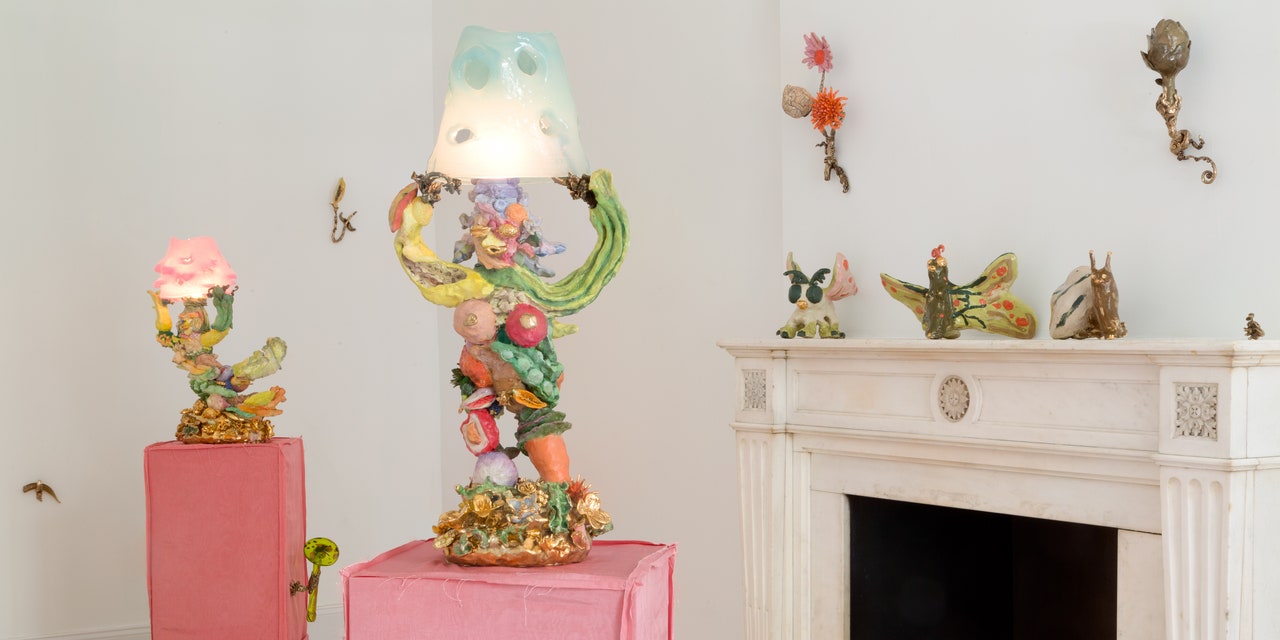The works also represent a material breakthrough for Stout, as they are the first to feature the unwieldy combination of bronze, ceramic, and glass. To accomplish a collaged, cornucopia-like effect, Stout worked with five assistants, including her friend, Blown Away competition show winner Deborah Czeresko, who made all the glassware. Ceramic artichokes, pomegranates, mushrooms, and more were made as oversized beads to string through a steel-tube frame.
The process is somewhat improvisational for Stout, who can never predict how the finished piece will look. For this project, the artist taught herself how to MIG weld, which she likens to using a hot-glue gun. “I would make portions of the body, then bead ceramic pieces on, and then weld the next limb on as I went,” Stout explains. Final touches include applying metal and adorning facial features and other details, such as the nipples that ingeniously function as touch switches, with 18-karat-gold plating.
“I think fruit and vegetables and flora in general are strong metaphors for life, death, and sexuality,” says Stout. With their anthropomorphic nuances and humor, the lamps reinvent the psychologically stirring work of past masters, including 16th-century portraitist Giuseppe Arcimboldo, known for depicting faces formed from fruits and vegetables. And like Hieronymus Bosch’s scenic paintings, the longer you stare at Stout’s statuesque designs, the more microcosms you discover.
The fruit and vegetable details lend Stout’s pieces a mad-scientist, Franken-fruit quality. The artist herself admits to feeling like she was “dissecting the body,” a sentiment that gained more resonance after her husband suffered a brain hemorrhage during her making of this series. Born with a cavernous “malformation” (hence Stout’s exhibition title), her husband thankfully underwent a successful surgery. Adding another layer to her lamps’ body-as-vegetation theme, however, one of the neurosurgeon’s comments remained engraved in Stout’s mind: “He kept saying that the operation was like ‘removing a mole the size of a garden pea.’”
Complementing the two virtually life-size lamps are smaller ones, as well as “wall jewelry,” another first for Stout. With these purely ornamental pieces placed throughout the gallery, butterflies and snails seem to crawl up the wall, where flower buds and plants are also sprouting. “I wanted to help the viewer see the individual moments in the lamps,” says Stout.
The artist has more shows underway featuring works comprising bronze, ceramic, and glass, a combination that has been personally revelatory for her. “I cried every time these Lady Lamps left the studio. I could have kept working on them for the rest of my life,” says Stout, who dreams of designing her own sculpture garden, akin to Saint Phalle’s Tarot Garden, one day. “Niki so seamlessly wove all these disciplines of art and design together and really made them a part of her life,” Stout, who also admires Kusama’s textures, obsessive nature, and immersive installations, notes. And yet, as inspired as she might be by other women currently dominating the New York art scene, Stout has undoubtedly created a world that’s all her own: “If you left me alone, the whole room would have looked like my fruits and plants were growing out of it.”
